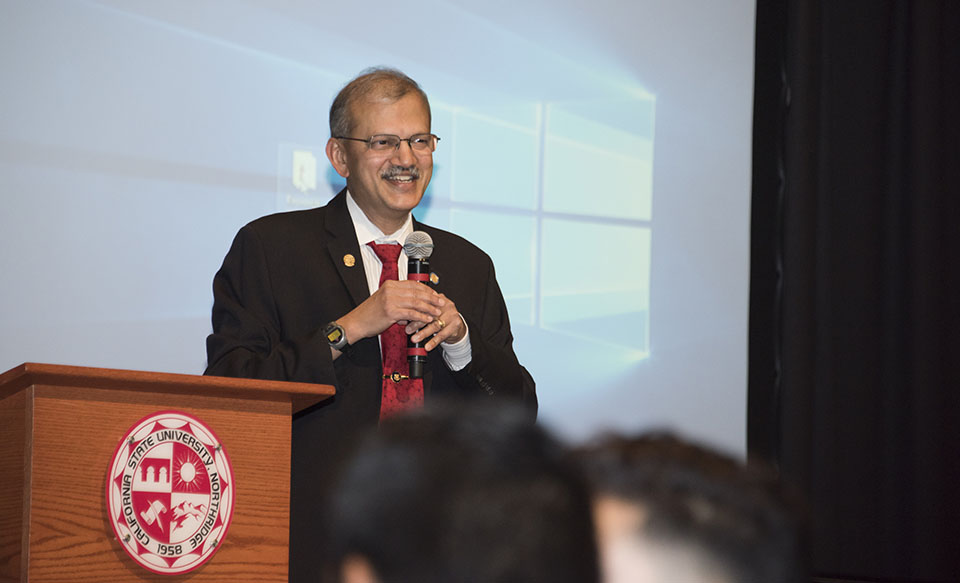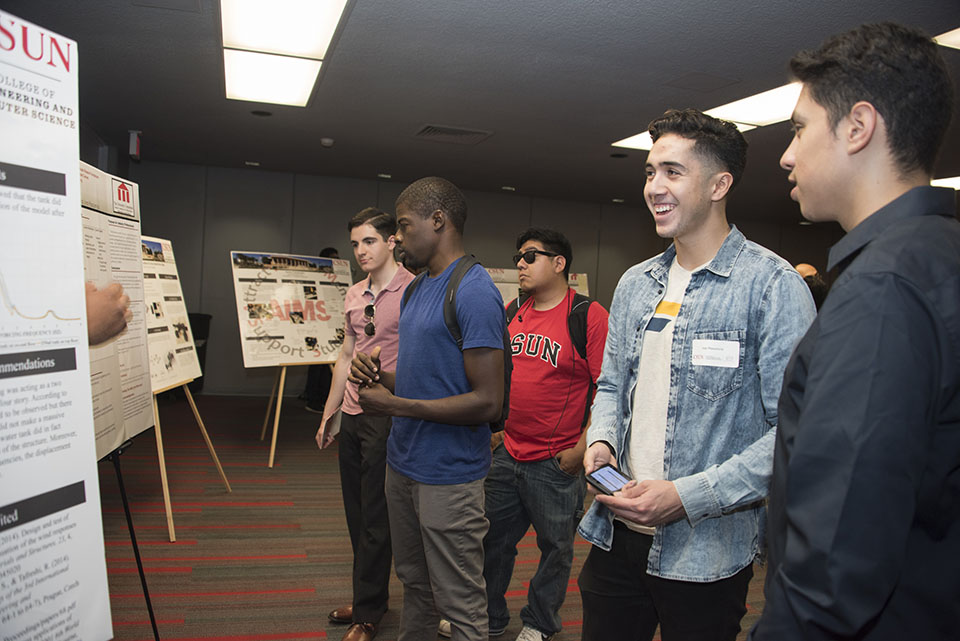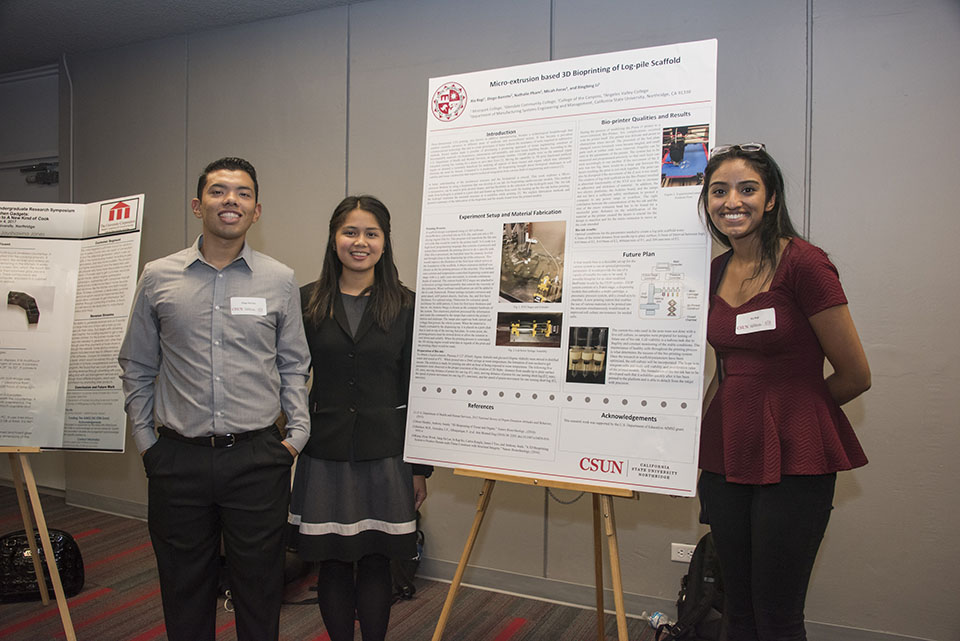AIMS2 Engineering Symposium Showcases Students’ Research
Engineering and computer science faculty organized the symposium to give students enrolled in the AIMS2 program an opportunity to present their projects in a professional forum.
The U.S. Department of Education has funded the AIMS2 program for the past six years, beginning with the initial grant in 2011. In 2016, the CSUN program’s collaborative grant was renewed with a $6 million grant. The original grant was designed to support low-income, economically disadvantaged and underrepresented Latino students and other students of color interested in majoring in engineering or computer science.
Program director S.K. Ramesh, former dean of the college and currently a professor of electrical and computer engineering, hosted the free event in the University Student Union’s (USU) Northridge Center.
“The big challenge that we have is to get the word out [about AIMS2],” Ramesh said. “Symposiums like these … empower students … to know they should ask the right questions, to think about their education and careers, and to think about their impact on society.”
Students enrolled in the AIMS2 program have access to academic resources such as professional mentors, tutors, educational field trips, workshops, grants, $500 semester stipends, career opportunities and paid internships for undergraduate research participation.
At the Oct. 4 research symposium, under the direction of faculty mentor Vahab Pournaghshband, computer science major Aren Mark Boghozian presented his collaborative research project, Simulating Network Discrimination by Intermediaries on the Internet — which aimed to improve internet speed. A first-generation college student, Boghozian started his higher education at Pasadena Community College and learned about the AIMS2 program through an email campaign.
“It’s not only the project. The faculty mentors are always there for you,” he said. “They go over your classes, what you are supposed to take and basically show you the right path. I came here last year, and I am already graduating [in May]. That is because my faculty mentor helped me a lot in choosing the right classes to finish in two years.”
In the AIMS2 program, Pournaghshband mentors nine CSUN students, working to ensure that their academic needs are met.
“Students come from different backgrounds, in terms of level of knowledge,” Pournaghshband said. “As educators and professors, our job is to make sure that those students who actually didn’t have that practice or knowledge before don’t feel discouraged by others already [having] programming skills.”
Unsure of where to go after completing community college, junior Christina Seeholzer made the decision to transfer to CSUN to major in mechanical engineering and minor in physics, with the assistance of the AIMS2 program.
“I heard about AIMS2 from my engineering professor at Pierce [College]. She really encouraged us to join the program,” said Seeholzer. “The AIMS2 program really helped me zero in on CSUN. AIMS2 creates this atmosphere of belonging, because most of the people in AIMS2 are low-income, transfer or first-year students and people of color. Having that type of support system is really great.”
At the symposium, Seeholzer presented her collaborative research project, Smart Kitchen Gadgets: Opening the Kitchen to a New Kind of Cook, with faculty mentor Shereazad (Jimmy) Gandhi.
The first five-year AIMS2 grant served approximately 250 students across seven cohorts at CSUN. Currently, the program includes 91 students in four cohorts. College of Engineering and Computer Science faculty lead the project in partnership with faculty from CSUN’s Michael D. Eisner College of Education and College of Science and Mathematics — as well as Glendale Community College, College of The Canyons, Moorpark College, Los Angeles Pierce College and Mission College. Initially, the program focused on supporting transfer students, but is now open to all first-time freshmen as well.
Excelencia in Education recognized the AIMS2 program in 2014, and the program earned a Bright Spot in Hispanic Education award in 2015 from the White House Initiative for Educational Excellence for Hispanics. According to Ramesh, students who have successfully completed the program are now “bridging the gap” by graduating at the same rate or just as fast as their better-served peers. AIMS2 is being used as an academic model nationwide.
“Fundamentally, we [the college] have been looking at student success long before the California State University (CSU) started to look at graduation rates,” Ramesh said. “In my case as a dean, I was very concerned about the gaps in graduation rates between underserved students and better-served students. In the College of Engineering and Computer Science, that number was in the double digits for transfer students when the AIMS2 program was initially funded in 2012.”
The program’s primary goal is to improve students’ research skills by introducing research projects early on in their educational careers.
“This not only makes [students] curious about how to find better solutions for existing problems, it also better prepares them to go into the industry — thus reducing the gap between what is taught in our programs and what industry wants,” Gandhi said. “It also ties in with student success, as recent data has shown that AIMS2 students take more credits and maintain higher GPAs than their counterparts who do not.”
To learn more or get involved with the AIMS2 program, please visit http://www.ecs.csun.edu/aims2.




 experience
experience